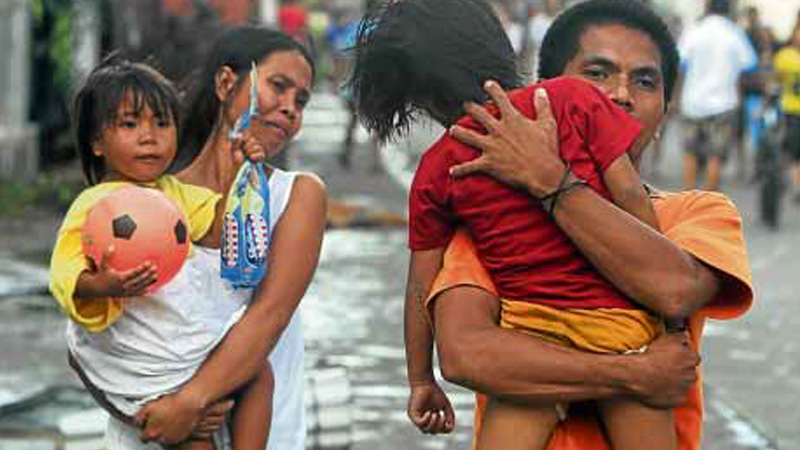
FACES OF TRAGEDY Carrying his dead daughter, a man heads for the morgue with hiswife and other child in Tacloban City’s downtown area after Supertyphoon “Yolanda” unleashed a storm surge on their community. —NIÑO JESUS ORBETA
(Editor’s Note: This series contains excerpts from the thesis submitted by the author to Harvard University for his master of liberal arts [ALM, concentration: International Relations] degree. The research, titled “Building Climate Resiliency in the Philippines: A Bottom-up Approach to Implementing Disaster Risk Reduction Strategies Through Analysis of the Impacts of Supertyphoon Yolanda in 2013,” was well received by the Harvard community when it was first presented during the May 18, 2016, thesis symposium at Cambridge, Massachusetts. It eventually earned the “Director’s Prize for Best ALM Thesis” during the 365th university commencement on May 26.)
(First of five parts)
Supertyphoon “Yolanda” (international name: Haiyan), which lashed Eastern Visayas on Nov. 8, 2013, is so far the strongest typhoon to make a landfall in recorded history.
The Hawaii-based Joint Typhoon Warning Center (JTWC) and the National Aeronautics and Space Administration (Nasa) estimated Yolanda’s top sustained winds to have reached 314 kilometers per hour when it hit land, with gusts of 378 kph. No other storm has come closer to Yolanda’s fury.
Yolanda generated storm surges that left a trail of death and destruction, unleashing the full destructive force of a climatic event consistent with the predicted effects of climate change.
By the time it exited into the West Philippine Sea the following day, the swath of destruction was wider than initially reported.
Poverty aggravated
Yolanda aggravated poverty in the countryside, slowing down rural development in the Visayas and scaling back the economic growth of the whole country.
The Inquirer, through an extensive research conducted by this writer from 2015 through 2016, reviewed the aftermath of Yolanda, including the government’s shelter assistance to the survivors.
Humanitarian agencies, international nongovernment organizations (NGOs) and other local private donors, have built shelters, too, but tallying them proved to be a challenge because the data sets on shelter assistance (cash and other nonmonetary shelter support) were not in one place during the data-gathering phase of the research.
The study analyzed the enduring impact of Yolanda in relation to the government’s overarching goal to build climate resilience.
It focused on Yolanda’s role in shaping the country’s climate change response, which chiefly refers to the enactment of national policies and their actual implementation toward combatting climate change after 2013.
Shelter assistance
The Multi-Cluster/Sector Initial Rapid Assessment (Mira) identified shelter as the most challenging gap in the response period following Yolanda. Mira is the first step in the UN-coordinated global response to a humanitarian emergency like Yolanda.
More than 40 agencies under the Office for the Coordination of Humanitarian Affairs (Ocha) conducted Mira in nine provinces to survey the impact of the supertyphoon.
Released in December 2013, Mira unequivocally called on humanitarian actors to immediately deal with shelter concerns so that survivors could build temporary shelters once debris and rubble were cleared from their plots of land.
“With the risk of up to four more storms in the coming months, shelter concerns are a top priority,” Mira said.
Watershed climatic event
Available data supported the claim that Yolanda was a watershed in the history of climate governance in the country because the ensuing chaos, paralysis and societal breakdown in its immediate aftermath turned a natural hazard into a humanitarian crisis.
Natural hazards, such as typhoons, earthquakes and tsunamis, may not necessarily turn into disasters, which global emergency responders believe are all manmade.
In Yolanda’s case, it was the Philippines’ low adaptive capacity—the low level of preparedness and very slow emergency response of the humanitarian actors led by the national government—that eventually shaped the pace of the recovery of the affected population.
The study established the connection between the magnitude of the disaster and the inability of the people and their government to anticipate the full extent of a hazardous event like Yolanda.
For instance, before Yolanda struck, Tacloban was particularly ill-prepared to deal with the impact of storm surges that were forecast to inundate coastal communities facing the country’s eastern corridor; and so was the government.
The societal breakdown and the paralysis of the government’s first responders were particularly acute in storm surge-ravaged Tacloban and various parts of Samar and Leyte provinces that were in the direct path of the storm.
(To be continued)